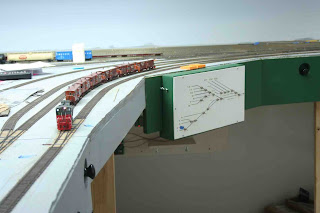Preparing for
the next operating session, I have been tackling a number of “little” tasks
that were postponed for lack of time or higher priorities. Such has been the fate of my caboose track in
the Eugene Yard complex. The caboose
track is just off the RR-East switch lead, with switches close to the layout
edge. Therein lay the problem leading to
delay. These switches use Blue Point
manual throw switch machines, just as many within the yard complex.
The Blue Point
throw arm is 7/8 inch below the underside of the subroadbed. My standard throw rod mount through the
fascia is 1-1/2 inch below the subroadbed to provide for an inset knob on the
layout face. This leads to a very
difficult mechanical function unless the throw rod can be attached to a lower
point on the switch machine. My prior
attempts at mounting close-to-layout switch machines involved a switch machine throw
bar bracket that lowered the mounting point.
These have not been completely successful.
Former offset throw
rod bracket on Blue Point switch machine mounted near layout edge. Brass bracket mounts to Blue Point throw bar
at top. Throw rod through the fascia
attaches at bottom of bracket.
My former offset
mounting bracket was a case of me getting too complicated—because I could. Sometimes it is a curse to have
well-developed modeling and small parts fabrication skills. This was one of those times.
After thinking
about this for a long time, the idea light bulb finally lit! All I needed was an offset of the entire
switch machine further below the subroadbed.
My Intro to Mechanical Engineering professor’s words are now ringing in
my ears: “The SIMPLEST solution usually
is the BEST solution!” Color my face red
and my forehead properly smacked by hand palm.
All I needed to do was mount a spacer block for the switch machine,
dropping the throw bar to my standard layout fascia throw rod mount location.
New Blue Point
mount with the machine moved further from the subroadbed with a spacer block.
With this
roadblock cleared, I could mount switch machines for the switches at either end
of the caboose track. The track switches
have been on the layout for most of a year.
Now they are ready for service.
While I was at it, I mounted the switch machines for the Oregon Electric
Interchange track, further along the switch lead. That also prompted wiring said O.E. Interchange
track and the switches. Now I just need
to add some waybills for transfers to and from the Oregon Electric (BN).
SP 2732 switches
the caboose track.





